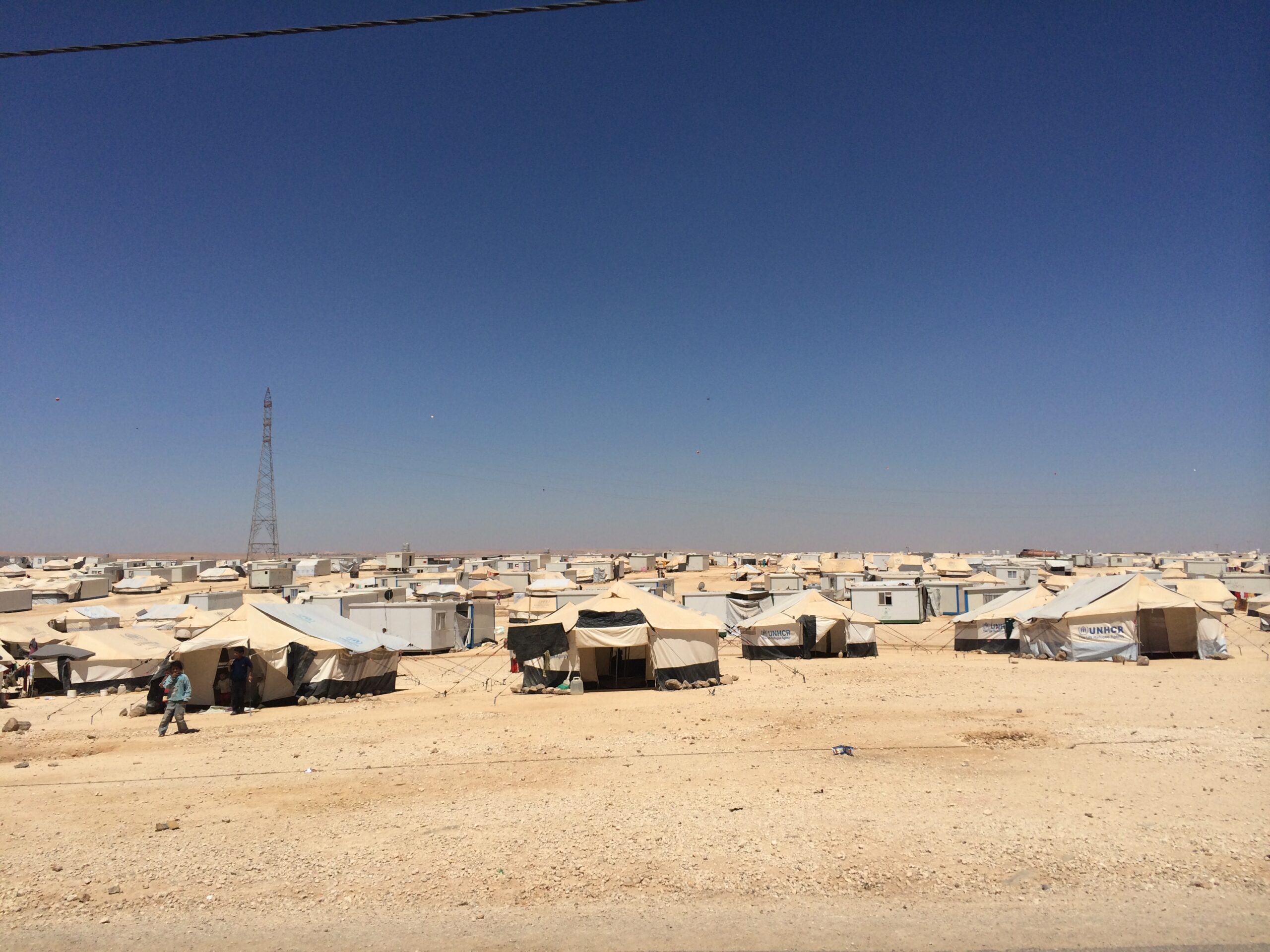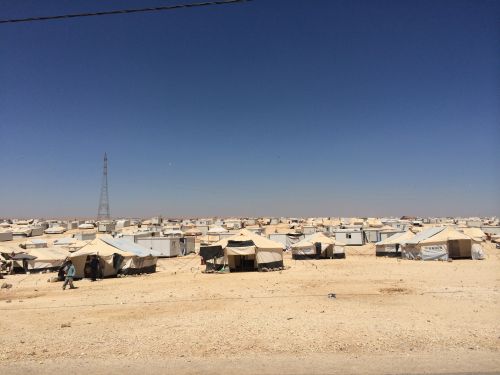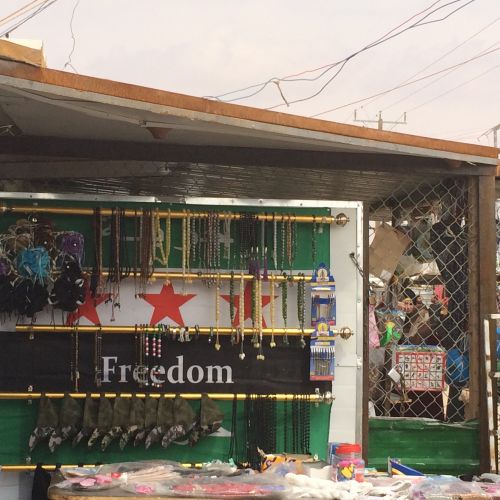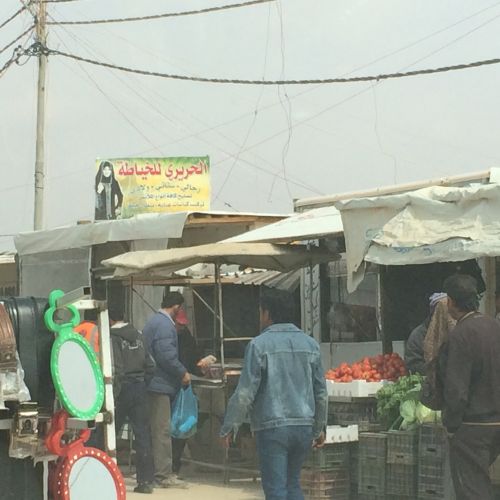BY MERISSA KHURMA, PANGYRUS
This article is being published in collaboration with Pangyrus.
A Jordanian woman in the Northeastern city of Mafraq had been nagging her husband for weeks to take her to the Za’atari refugee camp. Her request was a simple one, Magdoos, baby eggplants stuffed with walnuts and sun-dried red peppers and pickled in olive oil and garlic. A prominent Syrian staple for breakfast and dinner, these mouthwatering eggplants are often prepared at home in autumn, then preserved in traditional jars and consumed all year long. The Zaa’tari camp was now home to the best Syrian-made Magdoos. Disgruntledly, the husband finally caved and the Jordanian couple started their 10-kilometer journey to the camp, in search of the Syrian specialty.
The third largest refugee camp worldwide, Za’atari is home to more than 80,000 Syrian refugees today. Divided into twelve districts with tents, one-room prefabricated housing units, football pitches, playgrounds and a bustling market street, Za’atari has morphed into an informal city. In population terms, it is Jordan’s fourth largest city. “We built a camp and the Syrians built a city,” is a phrase often heard amongst politicos and opinion leaders in the more developed and modernized Jordanian capital. More than 70 kilometers from Amman and 13 kilometers from the Jordanian-Syrian border, the Za’atari camp may resemble a shantytown, but according to the world’s refugee agency, UNHCR, its economy generates around 14 million dollars every month. In addition to the delectable Syrian Magdoos, Za’atari’s market street, known as the ‘Champs-Élysées,’ offers a plethora of products. Some goods are produced in the camp, primarily food, beverages and traditional textiles, and others are traded with Jordanian towns near by.
While it remains surrounded by barbed wire and guarded by Jordanian security forces, “Za’atri still has a soul,” reflecting the resilience of the Syrian people, says Andrew Harper, UNHCR head in Jordan. “The refugee response has worked thus far,” he adds; however, five years into the Syrian conflict and the refugee crisis, Syrians “are losing hope and sense of purpose.” Similarly, Jordan, the third largest host country after Lebanon and Turkey, with more than a million Syrians, is still struggling to adequately address the myriad challenges associated with the influx of refugees. It is not merely a transient refugee crisis. It is a long-term and complicated reality particularly given Jordan’s already challenging political and economic conditions. Surrounded by turbulent conflict and ISIS threats, Jordan’s economy is lagging behind with slow GDP growth at 2.4 percent , high unemployment at 13 percent, and a state budget deficit of 1.3 billion dollars in 2015. The closure of land trading routes with Syria and Iraq has adversely impacted Jordan’s trade, especially given that both neighboring countries have traditionally been its largest trading partners. Regional conflict and the general perception of insecurity associated with the Middle East have also affected tourism, one of Jordan’s key sectors. This reality, compounded by the UNHCR statistic that it takes 17 years on average for a refugee to return to their home country, underlines the severity of Jordan’s predicament.
More than a jar of Magdoos
The Jordanian husband waited impatiently in the car as his wife dashed enthusiastically into the Magdoos haven, a decorated prefab home attached to a UNHCR tent.
A white bearded Syrian man approached the car, accompanied by a young woman whose innocent face was covered by a niqab, often worn by ultra-conservative Muslim women. The two men barely exchanged pleasantries before the white-bearded elder offered his young daughter. She unveiled her beautiful face to the perfect Jordanian stranger and the deal was sealed. Within moments, the teenage Syrian girl not only became a bride, but another good, sold in the thriving Za’tari market. As distasteful as it is, the likes of this child bride transaction have been on the rise alarmingly amongst the Syrian refugee population in Jordan since the beginning of the conflict in 2011. According to a UNICEF report, the percentage of registered Syrian child marriages, under the age of 18, increased from 12 percent in 2011 to more than 30 percent in 2014. This surge reveals that the pressures of displacement and economic hardship experienced by Syrians are driving families to marry their daughters at an early stage. In fact, various international assessments of the situation in Jordan converge around poverty and lack of unemployment amongst Syrians as a major contributing factor to the rise of child marriages. Other reasons cited by the studies include low levels of education, conservative religious or cultural views, and ‘compelling circumstances’ such as sexual abuse or pregnancy.
Bound Together
The Jordanian wife returned to the car with a jar of Magdoos and a wide smile painted across her face. She noticed the young lady settled in the back seat; her smile withered away as her husband started the engine. “We are giving her a lift to Mafraq city,” he claimed. It was not until they returned to their modest abode that he introduced his Jordanian wife to his new Syrian bride. “How can we afford this?” bewailed the Jordanian wife; end of story. This story was circulated widely, particularly amongst Jordanian women of Mafraq, worried about their husbands and families amidst rising rates of Syrian child marriages. While marrying a second wife is legal and acceptable in Jordan, it is neither the norm nor is it celebrated akin to other Muslim societies in the region. Any marriage should also be officiated by a sheikh, however, according to the UNICEF report, Syrian refugees in Jordan “are reportedly accepting that this role be performed by a stranger,” which in many cases increases the risk that these marriages are not conducted in “good faith.”
The fate of this particular young Syrian bride is unknown. However, the stories of other young Syrian brides across Jordan illustrate a painful reality. “I got married at the age of 13. I never really had the chance to get to know my husband until his family wanted him to marry me,” recounted Hania, a 15-year-old Syrian girl, according to a Save the Children report. Reem, also 15, said she feels “sad when I see other girls from my neighborhood going to school. Whenever I see a woman who has become a doctor or a lawyer or has finished her education, I get upset.”
This captures the essence of the challenge faced by both Syrian refugees and their Jordanian hosts, not only regarding early marriage, but also the impact on the girls’ future, the families and community. Particularly in Mafraq, where the Syrian refugees outnumber their Jordanian local hosts, it is a reminder that both communities’ future is bound together. It is also a window into the severity of the socioeconomic situation facing both Syrians and Jordanians; a dual challenge for the Government of Jordan as the Syrian conflict enters its fifth year.
“It is essential to think about both refugees and host communities, especially the poorer communities of northern Jordan,” notes Curtis Ryan, an expert on Jordanian and Middle East politics. “Any move beyond crisis, and toward longer term support and development is worth trying,” he adds. The Government of Jordan is certainly moving in this direction.
At the London donor conference for the Syrian refugee crisis in January 2016, the Jordanian government issued a statement, referred to as the “Jordan Compact,” outlining a creative and collaborative approach between the government and the international community to addressing the Syrian refugee challenge. The plan focuses on turning the refugee crisis into an opportunity for development. This newly recalibrated policy entails addressing the needs of local host communities and building their resilience, attracting new foreign direct investment, and preferential access to the European Union’s market for Jordanian exports. More importantly, this new thinking includes creating 200,000 jobs for Syrians, according to Imad Fakhoury, Jordan’s Minister of Planning and International Cooperation. However, issuing work permits for Syrians, while beneficial for both refugees and the host country, is also “politically complicated, at a time when a part of Jordanian society is hypersensitive to demographic changes and identity politics,” remarks Ryan. These concerns can certainly be assuaged, though by creating jobs for Jordanians as outlined in the Jordan Compact. Moreover, according to a report issued by the International Labor Organization (ILO), despite the increase of informal Syrian refugee economic activity in four principal governorates hosting the largest number of Syrians (Irbid, Mafraq, Zarqa and Amman), “there is little change in the total number of economically active Jordanians there.” The ILO report also reveals that Syrian workers in agriculture, construction and other sectors known to be less attractive to Jordanians have had a more negative impact on migrant workers who normally occupy these jobs.
Getting to Work
UN Resident and Humanitarian Coordinator Edward Kallon has praised the Jordan Compact as a “bold and innovative” framework, but many opinion leaders question its overly ambitious plan, especially given the country’s economic and political difficult reality.
“Jordan needs to grow at approximately 8 percent per annum over a minimum of five years in order to gradually create the announced 200,000 jobs for Syrians, without increasing the local unemployment rate,” argues Omar Razzaz, who chairs the Jordan Strategy Forum, an Amman based economic focused think tank. A sobering assessment in light of the 2.4 percent growth Jordan’s economy has witnessed amidst difficult regional conditions. Razzaz adds that creating employment opportunities requires a fresh look at the Jordanian labor market context and the structure of the local economy. With an attractive promise from the EU under the Jordan Compact regarding lifting tariffs to Jordanian exports, efforts must be focused on “restructuring the economy towards exports especially outside of the Middle East region,” Razzaz argues, adding emphatically that “we have no choice but to get it right.”
To date, local newspapers reported that Jordan has received pledges worth $1.7 billion in grants to fund its new developmental approach to the Syrian refugee crisis. Some of this funding will go into the establishment of five new development zones where 50 percent to 70 percent of the jobs would be given to Syrians and the rest to Jordanians. These zones will not only take time to be up and running, they also require more than the dollars pledged in new investments to create the 200,000 jobs announced by the Government of Jordan. Secretary General of Jordan’s Ministry of Planning and International Cooperation Saleh al-Kharabsheh told the Guardian newspaper after the London conference that even if you “attract new investments of $2bn,” can you, “maybe…be able to create tens of thousands of jobs,” but not 200,000. It is a colossal challenge.
Nevertheless, providing economic opportunities for Syrians as outlined in the Jordan Compact represents the only way forward. In addition to alleviating pressures on the Government of Jordan and addressing the deteriorating conditions of local host communities, it would also lessen the dependence on humanitarian aid, which has been dwindling in the past two years. In 2015, a mere 45 percent of UNHCR’s financial needs were met by the international donor community, leading many displaced Syrians in the major frontlines states, including Jordan, to embark on wobbly rubber boats into unchartered waters. For more than two thousand refugees, that was their last journey.
As UNHCR’s Harper noted, beyond the services provided that keep people alive, Syrians need to work, educate their children and have a “sense of purpose” for the future. UNHCR is certainly doing its part in coordination with the Government of Jordan to facilitate implementation of the Jordan Compact initiative. In April 2016, the refuge agency in Amman launched a pilot project to “help 2,000 Syrians get jobs in the export garment sector, as a partner of the ‘Better Work Jordan’ program,” run by the ILO, according to a press statement. Additionally, UNHCR is organizing “job fairs for Syrian refugees in community centers close to the relevant industrial zones,” noted the statement.
Such collaborative efforts are crucial to ensuring successful fruition of the Government of Jordan’s innovative and ambitious plan. Getting Syrians and unemployed Jordanians to work is a lengthy process that requires coordination and alignment of Jordan’s economic reforms and continued support from the international community, both governmental and non-governmental entities.
Such collaborative efforts are crucial to ensuring successful fruition of the Government of Jordan’s innovative and ambitious plan. Getting Syrians and unemployed Jordanians to work is a lengthy process that requires coordination and alignment of Jordan’s economic reforms and continued support from the international community, both governmental and non-governmental entities.
Five years into this largest humanitarian and refugee crisis, UN High Commissioner for Refugees Filippo Grandi offered a sobering message to all involved: “If the world fails to work together due to short-term interests, lack of courage and knee jerk reactions to shift the burden elsewhere, we will look back ruefully on this lost opportunity to act with solidarity and shared humanity.”
The Jordan Compact is no magical formula to the Syrian crisis. But it is the last best chance to inject a sense of normalcy and raise hope for a desperate yet resilient displaced Syrian population. It is an opportunity to act with “shared humanity” and to strengthen the social fabric of Jordanian society that has been adversely affected as well. If implemented correctly, the promise is that the young Syrian bride in the Magdoos story would dare to imagine a bright future for herself and her children. The promise is also that the Jordanian couple, whose fate changed dramatically with a jar of Magdoos, would have a chance to rebuild their familial bonds and give their children an opportunity to realize their aspirations.
This article is the product of a collaboration between Pangyrus and the Kennedy School Review. Pangyrus aims to foster a creative community of writers, artists, and academics. For more information, visit www.pangyrus.com.

Photos by Merissa Khurma



